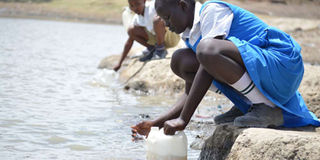Water scarce in Kisumu, Homa Bay as major rivers dry up

Pupils from Onjiko Primary School fetch water from a water pan in Ahero, Kisumu County, on February 20, 2018. The dry spell has forced the pupils to draw water from the pan for use at school. PHOTO | ONDARI OGEGA | NATION MEDIA GROUP
What you need to know:
- Rivers, water pans and bore holes have dried up in many areas in western Kenya.
- Sondu Miriu Hydroelectric Power Station is struggling to get enough water to run its turbines.
- The Kisumu Water and Sewerage Company is rationing water rationing.
It is Kennedy Otieno’s sixth trip to the water pan, almost a 5km ride from Wasare to Urudi, in Nyakach, Kisumu County.
He dips each of the 20-litre jerrycans into the water pan, then loads them onto his motorcycle and transports them to his home.
RIVERS
Nearly all the water bodies in his village have dried up, with the exception of the one at Urudi.
“This is the only water source that has withstood the harsh weather conditions in this area. It’s the water we can use for both domestic use and the livestock,” said Mr Otieno.
The water pan serves families residing in Gem, Agoro, Kabondo, Kasae and Wasare villages within Nyakach Sub-County.
Mr Otieno is among thousands of families in Western Kenya region counties staring at effects of drought.
Kisumu, Homa Bay, Siaya, parts of Kakamega and Vihiga counties have not had rainfall for a long time, causing rivers, water pans, ponds as well as bore holes to dry up.
Big rivers like Nyando, Kuja, Awach and Mirui have shrunk, leaving villagers in areas like Awasi, Ahero and Kajulu in Kisumu County and Kojwach in Homa Bay County in crisis.

The Sondu Miriu Hydroelectric Power Plant in Nyakach Constituency, Kisumu County, on February 14, 2018. Drought has led to low water levels at the plant, which could affect power generation. PHOTO | ONDARI OGEGA | NATION MEDIA GROUP
WATER
Sondu Miriu Hydroelectric Power Station is struggling to get enough water to run its turbines, while River Nyando that flows throughout the year from Nandi Hills is struggling, leaving rice farmers at the Ahero and West Kano Irrigation schemes a worried lot.
Livestock farmers walk several kilometres in search of water and pasture for their animals.
Meanwhile, the Kisumu Water and Sewerage Company (Kiwasco) water rationing entered its second week.
Manager Director David Onyango said there was a significant drop in the volume of water in River Kajulu, the main source of water for the town.
“This has resulted to intermittent supply of water in areas served by this plant, which covers Kondele, Mamboleo, Kajulu, Migosi, Lolwe, Kenya-Re, Kibos, Manyatta, Chiga, Riat and their environs.
“Customers in these areas are advised to use water sparingly and conserve what is received,” said Mr Onyango.
The United Nations and the Meteorological Department have attributed the prolonged dry season to changing weather patterns.




